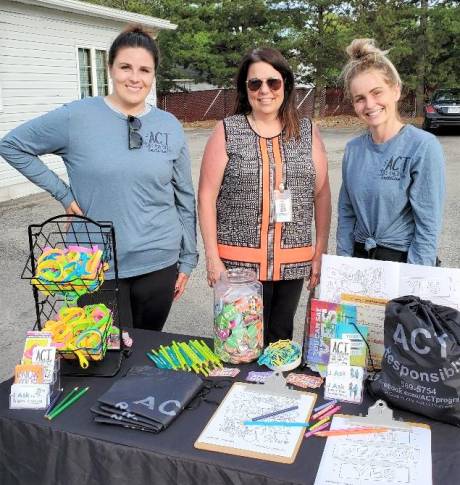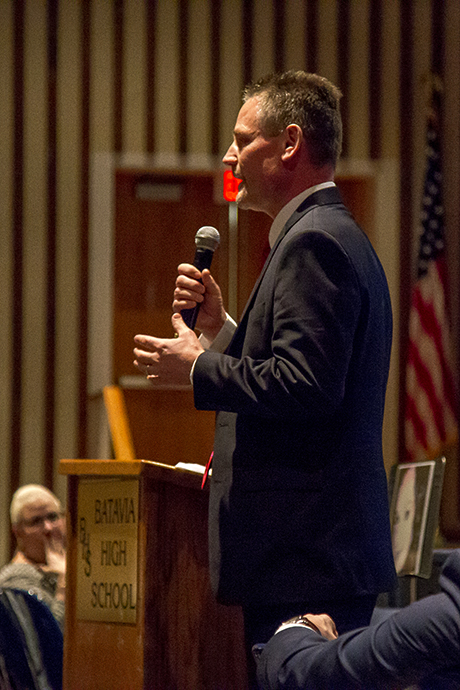Photo by Steve Ognibene of resident DEA agent-in-charge John Flickinger.
Morgan Brittany Axe came from a good family with friends and relatives who loved her. She played volleyball and became a cheerleader. She had relatives here who attended Batavia High School. She traveled the same streets we travel.
"She looked like you," her mother, Deanna Axe, told the crowd gathered Monday afternoon in the BHS auditorium. "She is you."
But Morgan died in December at age 24 from an overdose after losing a four-year battle to overcome heroin addiction. She was pregnant with Deanna Axe's grandson, Isaiah Douglas Lee Mathis, at the time of her death and the unborn baby died, too.
The heart-wrenching story was shared with students and about 100 community members at a forum called "Pay Attention: Addressing Prescription Drug Abuse and Heroin Addiction in Our Community."
Morgan's downward spiral was triggered when a young man she loved committed suicide while talking on the phone with her. She was devastated by the loss and a doctor prescribed Xanax. Later someone suggested "Try this, you'll feel better. And she did."
But in that one moment, everything changed. The pain was gone but only fleetingly. Then came the numbness, sadness, isolation, truancy, poor grades, joylessness, more drugs.
"The first time you choose, the second time the disease chooses you," Deanna said. "And the disease takes over. You can't get back no matter how hard you try."
Jail. Institutions. Death.
"Deal with life on life's terms. ... There's no situation in your life that can be overcome by taking drugs," Deanna said. "When you wake up tomorrow after the drugs have worn off, you have the same problems."
The Rachel Platten song "Stand By You" provided the soundtrack to a brief video showing highlights from Morgan's life. The cute little girl. The young adolescent cuddling the chocolate-colored puppy. The happy-go-lucky teen taking candid selfies with friends. The beautiful young woman with long dark hair and a winning smile.
"(Addiction) will knock you to your knees. ... Please don't take this path," Deanna said. "It will lead to disaster."
In addition to the first-hand account about the Axe family, the forum featured an overview by William J. Hochul Jr., U.S. Attorney for the Western District of New York (spanning 17 counties), and input from law enforcement personnel from Batavia PD, Le Roy PD, and the federal Drug Enforcement Agency. It was sponsored by a coalition of community volunteers known as Act Genesee, which promotes "healthy and safe choices through education and action." Representatives from the county, the Prevention Resource Center, State Police, GCASA, Batavia Urgent Care and others on the front lines of the opioid-addiction epidemic were also there.
Hochul said the United States has 4 percent of the world's population, but consumes 99.9 percent of the planet's hydrocodone. (A semi-synthetic opioid synthesized from codeine.)
"Either we have more people in pain here than the rest of the nations put together," Hochul said, "or something went wrong..."
Whether addiction starts with prescribed pain meds that become indispensable, pilfering pills a family member or friend's medicine cabinet, smoking marijuana laced with heroin, experimenting with synthetic opioids, or snorting or shooting heroin outright, the ultimate effect on the body and brain chemistry is the same, Hochul said. The road to addiction is typically sure and swift. It's also multifaceted and complex so a conversation about addiction to prescription painkillers needs to include the once-taboo topic of heroin.
The tragic irony is that once someone experiences that first high, they spend the rest of their days trying in vain to recapture the euphoria. If they can't get the prescription they want for pain meds or can't afford to pay $50 for a pill on the black market, they go for the cheaper stuff, and that's how heroin and synthetic opioids have come to grip so many.
(A PBS Frontline documentary which premiered Friday called "Chasing Heroin" artfully delves into the gritty reality of the national crisis. (Search Google and view online free.) Not to be confused with the 2010 documentary about an addict's world called "Chasing the Dragon," which was highly recommended by yesterday's panel.)
"This isn't the usual anti-drug message," resident DEA agent-in-charge John Flickinger said. "We're here because people are dying. This is different. It's mentally and physically addicting. After one hit, you are 'chasing the dragon.' People feel addicted for life. ... This truly is a drug that if you try it once, it may be the only thing you ever do. ... This is not something you want to experiment with -- it's too addictive."
Drug traffickers know this and they'll do anything to make a buck and get a customer for life, Flickinger said.
They often cut their product with "China white," a synthetic heroin called fentanyl, which comes from China and is very inexpensive but is 20 to 30 times more powerful than plant-based heroin. By cutting this into their product, they can stretch their resources and make more money. It just takes three or four grains (think as in grains of salt) in a dose or "fix" of heroin to amp up the high. But the traffickers plop it all in a household blender and mix it up, get the stuff packaged and out the door. They don't really know, or care, if there are three grains of fentanyl per dose or 23. It's all about the money, Flickinger said.
This is NOT a just a teen problem. It's way too big. The number of people killed every year from heroin and prescription drug overdoses exceeds those killed from violent crime, including gang-related deaths, and car wrecks combined.
In Erie County in 2015, more than 250 deaths are attributed to opioid overdose, Hochul said, noting that during the same year there were 40 homicides.
In addition, 650 people in Buffalo were categorized as "Narcan saves," said Act Genesee President Anita Strollo, meaning they would likely have died if not for law enforcement or medical technicians dosing them with the anti-opioid nasal spray Narcan, thereby reversing the effect of drugs in the users' system and keeping them alive.
In other words, the grim statistics would be greatly multiplied. But even the use of Narcan has become problematic, according to Le Roy Det. John Condidorio, who said the dope out there is so powerful nowadays instead of the one or two doses of Narcan that used to work, now three or four doses are required to pull someone back from the brink of death.
Sometimes the same people get a second chance more than once.
Condidorio said he's sick of being at the scene of a 14-year-old who overdosed, or a 16-year-old.
A women in the audience said during a Q&A session afterward that her child is struggling with heroin addiction. Her family is hurting, fearful, ashamed.
"It's the hardest thing I've ever had to do," she said about parenting an addict.
But she praised the addiction-treatment drug Vivitrol (naltrexone), which costs $1,800 for a month's supply, for bringing hope their way. For the past two years, it has been working.
It was also working for Morgan Axe. She was doing great taking Vivitrol and getting a handle on her life. But after she became pregnant at some point she decided to stop taking her medication out of concern for her unborn child. Then came the second most fateful decision she would ever make: to use once more; to get high just one more time.
She found her connection on Facebook and didn't have to drive to some dark alley in a big city; the goods were delivered right to her door. She used again, and died.
"Don't let this be your story," Deanna said. "Choose life. Choose reality. Okay?"
Panelists urged parents to keep tabs on their children's use of technology.
"If you aren't on your kids' social media and monitoring their cell phone calls every day, you're missing out on where they spend 90 percent of their time," Hochul told the audience.
He gave an example of a teenage girl who, along with friends, found ways online to "reverse engineer" so-called tamper-proof pills so they could get high. Hochul said if they had scanned the teens' browser history, they would've seen what they were up to.
Parents were also encouraged to read:
- "The Secret Life of Teens: Young People Speak Out About Their Lives" [Gayatri Patnaik, Michelle T. Shinseki]
- "The Secret Lives of Teen Girls: What Your Mother Wouldn't Talk About But Your Daughter Needs to Know" [Evelyn Resh, MPH CNM]
For family members or friends struggling with an addict, a new adult Nar-Anon group meets on Monday nights at 6:30 at Horizon Health Care -- Batavia Recovery Center, 314 Ellicott St., Batavia. March 7 will be the third meeting.
Addicts are welcome to attend the Narcotics Anonymous meetings three times a week at The Salvation Army, 529 E. Main St., Batavia. They are at 6:30 p.m. on Tuesdays; 7:30 p.m. on Thursdays; and 7 p.m. on Fridays.
"You are not alone," Deanna told the audience. "If you want help, there is help for you."



